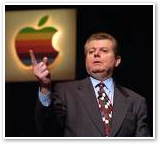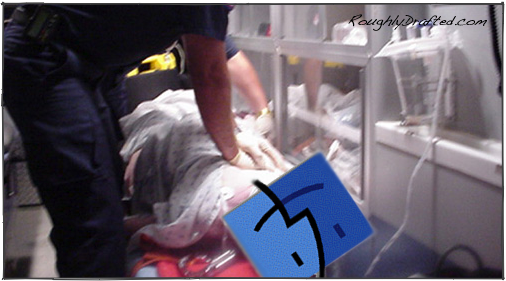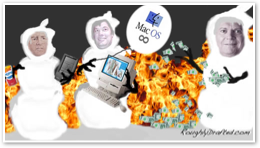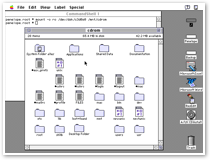
How CPR Saved Apple
Why Apple Failed challenged the commonly held idea that Apple's troubles throughout the 90's were tied to its small share of the overall market. Instead, it presented PC market share as a red herring the company's executives ineffectually chased after in efforts to become more like other PC makers--or alternatively, like Microsoft--while the real solution evaded their grasp.
The efforts the old Apple took throughout the 90's not only failed to boost market share, but actually distracted the company away from what was the really critical problem: potential new customers had no reason to buy a Mac, while existing Mac users were finding compelling new reasons to move to Windows instead.
No amount of cheap hardware or increased availability would solve the core problem of Apple's dying Mac platform. Apple's attempts to solve the wrong problem just made the real problem worse.
It was as if the Mac's heart had stopped, but rather than CPR, Apple’s executives were trying to perform the Heimlich Maneuver.
Identifying the Real Problem
Being able to diagnose the underlying problem is the most important step in solving a crisis. Anyone who has suffered through a painful tech support call knows this.
By 1995, Apple's existing leadership began to realize that stagnant development of the Mac OS had ballooned into a severe crisis that was suffocating the Mac platform.
While Apple had made impressive efforts in 1994 to move its entire hardware platform from the dead end 680x0 processor to the modern new PowerPC, the company hadn't delivered similar progress to the software side of the platform.
Without a modern operating system, Apple would find it increasingly difficult to offer both new and existing customers any reason to buy a Mac, regardless of what new hardware was available.
This was a new problem; through the 80's, Apple had rapidly rolled out advances to the Mac system software. However, after System 7 was released in 1991, it only received a series of minor tweaks, and quality and overall stability of the Mac’s System Software fell dramatically. Much of the actual deliverables over the next half decade were little more than shareware apps that were rolled into what had become Mac OS 7. 

Apple's Advanced Technology Group was coming up with lots of interesting ideas, but the company wasn't turning them into reasons to buy a Mac. Apple was turing into another PARC, unable to deliver the software technology it invented.
The Case of the Dead Platform
As was detailed in Hitting the Wall, Apple had been caught in the Catch-22 of platforms: the now decade old Mac needed a major overhaul to allow for future development, but it was not clear what strategy would best accomplish that: replace, repair, or both? Apple had several projects in the oven:
-
•starting over from scratch and risking the release of a brand new platform, under the code named Jaguar
None of these would magically solve the problem directly, but all of them attempted to address what was the Mac's real problem: existing users progressively had fewer reasons to keep buying Macs, while new users increasingly had new reasons to buy a Windows PC instead.
Apple's dead end operating system and stagnant user environment were clogging the platform's arteries and stopping its heart. It only appeared to be choking on market share; the real problem was a lack of applications.
The Lifeblood of a Living Platform
Applications are the lifeblood of platforms. The original Mac had sat around as a curiosity until desktop publishing empowered it into a dynamic, multi-billion dollar platform. Apple had correctly identified a second wind for the Mac in multimedia, and maintained the Mac platform into the 90's on the back of QuickTime.
In the absence of being able to deliver impressive new operating system technology, QuickTime provided the second string for Apple's offensive line. QuickTime was a partial reason to buy Macs, but like the Mac GUI, it was also threatened with being duplicated by Microsoft on the PC.
 Microsoft first countered QuickTime with its own Video for Windows. Rather than being a complete architecture for multimedia content creation and editing, Video for Windows was simply a playback system. Of course, Apple had also ported QuickTime to Windows, but the core of QuickTime development remained on the Mac.
Microsoft first countered QuickTime with its own Video for Windows. Rather than being a complete architecture for multimedia content creation and editing, Video for Windows was simply a playback system. Of course, Apple had also ported QuickTime to Windows, but the core of QuickTime development remained on the Mac.This helped to establish Macs in multimedia content creation, where Apple maintained a significant presence. Microsoft’s rival contributions to multimedia throughout the 90s were almost entirely vaporware: Surround Video, Chromeffects, and a cross platform Active Movie were promoted but never delivered.
Apple made the mistake of keeping QuickTime a secret. The company's advertising failed to flaunt the Mac's superiority in delivering multimedia as a practical application. In addition to QuickTime’s more sophisticated architecture for content creation, Macs provided better integration with audio and video hardware than standard desktop PCs well into the late 90s, although Apple's lead was beginning to slip.
However, the Mac's heart had still stopped, and QuickTime was beginning to ache from the death of its underlying core operating system. QuickTime couldn't stand on its own for much longer.
CPR for a Dying Platform
After Apple bought NeXT in the final days of 1996, it was progressively revealed that Apple's development crisis was far larger than either customers or developers had been lead to believe.
Copland had already been outed as an undeliverable mess of vaporware, but now the remainder of Apple's publicly touted projects, including the Newton, PowerTalk, QuickDraw GX, QuickDraw 3D, HyperCard 3.0, and QuickTime interactive, were being exposed as development boondoggles with no future.
Each involved impressive bits of technology which were crippled by technical or commercial impracticality or were butchered by years of protracted product mismanagement. Moreover, all of Apple's Mac technologies were suffocating from the slow death of their underlying foundation: the core Mac OS.

Steve Jobs deftly wrestled control of the massive failure that Apple had become from existing CEO Gil Amelio, and lead a new team of executives and managers on a painful surgery of the company that slashed through layers of broken, undeliverable, or unmaintainable technologies.
Scores of projects were "steved," which had become the new euphemism at Apple for killing projects due to their incompetence or impracticality. A series of disgruntled middle managers and snowball in hell project overlords left the company in disgust after their pet projects were summarily executed.
Open Heart, Proprietary Bypass Surgery
The new Apple cut through layers of fat to replace its bloated, dying technology organs with more maintainable and open alternatives.
The core of the Mac OS was replaced with a functional, modern operating system based on NeXT's proven Mach-BSD kernel, which provided the ability to deliver preemptive multitasking and protected memory for new applications.
That also made POSIX the core system API for the new Mac OS X, allowing easy portability of code from other POSIX platforms, including Linux and BSD. Twenty years of crusty core Mac OS code were replaced with modern, state of the art technology from BSD, including the world's most advanced networking software.
The seven year old QuickTime, now stagnating at version 2, was cleaned up and the core of QuickTime was scheduled to migrate towards a modern future. Regular new updates of QuickTime pushed it towards that goal, with major releases nearly every year after the release of 3.0 in 1998.
The archaic QuickDraw and QuickDraw 3D were replaced with plans for an entirely new drawing system: Quartz 2D drawing was based on the open PDF model, while the overwrought, proprietary mess of QuickDraw 3D was replaced with a far more standard implementation of the OpenGL specification.
The valuable existing technology assets from both Apple and NeXT were cleaned up and modernized to present a new integrated development environment which drew upon the existing Mac APIs already in wide use, while also leveraging the object oriented frameworks from NeXT.
After nearly a half decade of development work, the initial release of Mac OS X was finally delivered. But while Apple had fixed many of the underlying technical problems that had been killing the platform, there was still the same, lingering problem of applications: why would anyone chose a Mac over the ubiquitous Windows?
Stumbling onto a Killer Fix
A decade of decline had slowly poisoned the Mac platform; it took many years to revive the core OS back to health as a state of the art platform. However, even with a fresh and modern operating system, Apple still needed to figure out how to drive new Mac sales. It needed applications.
A new OS on modernized hardware offered a compelling upgrade to existing Mac users, but Apple needed to expand the Mac market. While there are several significant components to the recovery plans Apple executed, there was a key turnaround discovery that the company stumbled onto in a fortunate accident.
This Series










Monday, October 23, 2006






 Bookmark on Del.icio.us
Bookmark on Del.icio.us Discuss on Reddit
Discuss on Reddit Critically review on NewsTrust
Critically review on NewsTrust Forward to Friends
Forward to Friends
 Get RSS Feed
Get RSS Feed Download RSS Widget
Download RSS Widget





